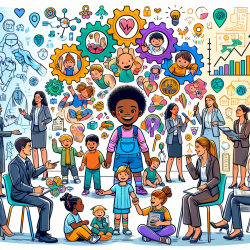As practitioners dedicated to fostering optimal outcomes for children, it is crucial to stay informed about the latest research in our field. A recent study titled "Developmental Language Disorder and Autism: Commonalities and Differences on Language" provides valuable insights into the intersection of Developmental Language Disorder (DLD) and Autism Spectrum Disorder (ASD). This blog aims to highlight key findings from the study and suggest practical applications for enhancing therapeutic interventions.
Key Findings
The study investigated the language abilities of children with DLD, ASD, and typically developing (TD) children, focusing on identifying commonalities and differences. Here are some significant findings:
- There is a subgroup within the ASD population that exhibits language impairments similar to those seen in children with DLD.
- Both the ASD-LI (ASD with Language Impairment) and DLD groups scored lower on language measures compared to TD children, indicating a common pathology in language ability.
- Tasks such as Non-Word Repetition (NWR) and Sentence Repetition (SRT) were effective in distinguishing children with language impairments from their typically developing peers.
- ASD and DLD children showed similar performance in several language tasks, suggesting a potential overlap in the phenotypic presentation of these disorders.
Practical Applications
Based on these findings, practitioners can consider the following strategies to improve therapeutic outcomes:
- Utilize Specific Language Tasks: Incorporate NWR and SRT tasks in assessments to accurately identify language impairments in children with ASD and DLD. These tasks are reliable markers of language deficits and can guide targeted interventions.
- Tailor Interventions: Recognize that children with ASD-LI may require interventions that address both language and social communication deficits. Customized therapy plans should consider the unique combination of impairments in this subgroup.
- Focus on Pragmatic Skills: Given the overlap in pragmatic impairments between ASD and DLD, interventions should include activities that enhance pragmatic language skills, such as role-playing and social stories.
- Collaborate with Multidisciplinary Teams: Work closely with psychologists, special educators, and other professionals to develop comprehensive intervention plans that address the multifaceted needs of children with ASD and DLD.
- Encourage Further Research: Stay engaged with ongoing research to refine and update therapeutic approaches. Understanding the evolving landscape of language disorders will ensure that interventions remain evidence-based and effective.
Conclusion
The study "Developmental Language Disorder and Autism: Commonalities and Differences on Language" underscores the importance of recognizing the nuanced relationship between DLD and ASD. By integrating these research findings into clinical practice, practitioners can enhance their diagnostic accuracy and therapeutic effectiveness, ultimately leading to better outcomes for children.
To read the original research paper, please follow this link: Developmental Language Disorder and Autism: Commonalities and Differences on Language.










